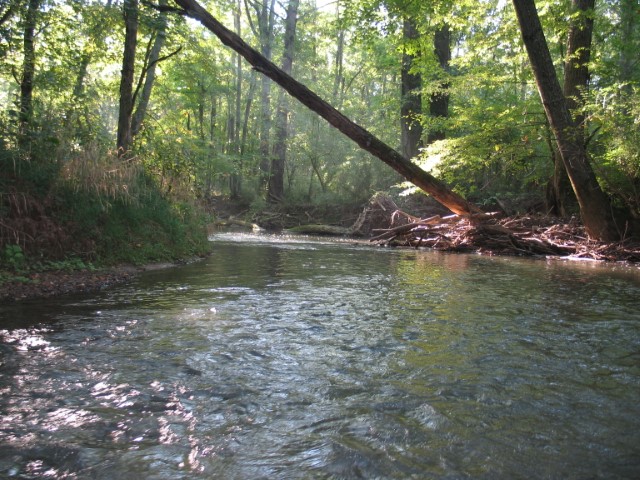03/31/2016
Mercury and Methylmercury Dynamics in an Industrially Contaminated Stream
Algal biofilms found to be major generators of toxic methylmercury in streams.

Dissolved mercury increases during high flow events in streams.
[Image courtesy Oak Ridge National Laboratory]
The Science
Detailed monitoring of changing mercury (Hg) and methylmercury (MeHg) concentrations in a creek during baseflow and flood events indicates that MeHg is produced within the stream and further suggests that algal biofilms, also called periphyton, are major sources of MeHg production.
The Impact
These findings may explain why past improvements in overall stream water quality have not resulted in concomitant improvements in MeHg concentrations in water and in fish. Additionally, future alterations to stream management practices or climate that alter periphyton abundance, activity, or composition may have unintended negative consequences that could influence MeHg production within the creek.
Summary
Sediments and floodplain soils in the East Fork Poplar Creek (EFPC) watershed in Oak Ridge, Tennessee, are contaminated with high levels of Hg from an industrial source at the headwaters. While baseflow conditions have been monitored, concentrations of Hg and MeHg during high-flow storm events (when the stream is more hydrologically connected to the floodplain) had not yet been assessed. This study evaluates EFPC baseflow and event-driven Hg and MeHg dynamics 5 km upstream of the confluence with Poplar Creek to determine the importance of hydrology to instream concentrations and downstream loads, and to ascertain if dynamics are comparable to systems without an industrial Hg source. Particulate Hg (HgP) and MeHg were positively correlated with discharge (r2=0.64 and 0.58, respectively) and total suspended sediment (r2=0.97 and 0.89, respectively). Dissolved Hg (HgD) also increased with increasing flow (r2=0.18) and was associated with increases in dissolved organic carbon (DOC; r2=0.65) similar to dynamics observed in uncontaminated systems. Dissolved MeHg (MeHgD) decreased with increases in discharge (r2=0.23) and was not related to DOC concentrations (p=0.56), dynamics comparable to relatively uncontaminated watersheds with a small percentage of wetlands (<10%). While stormflows exert a dominant control on HgP, MeHgP, and HgD concentrations and loads, baseflows were associated with the highest MeHgD concentration (0.38 ng/L) and represented the majority of the annual MeHgD load.
Principal Investigator(s)
Scott Brooks
Oak Ridge National Laboratory
[email protected]
Funding
This work was supported by the U.S. Department of Energy’s (DOE) Subsurface Biogeochemical Research program within DOE’s Office of Science Office of Biological and Environmental Research. The isotope(s) used in this research were supplied by DOE’s Isotope Program within DOE’s Office of Science Office of Nuclear Physics.
References
Riscassi, A., C. Miller, and S. Brooks. “Seasonal and flow-driven dynamics of particulate and dissolved mercury and methylmercury in a stream impacted by an industrial mercury source.” Environ. Toxicol. Chem. (2015). DOI:10.1002/etc.3310.
